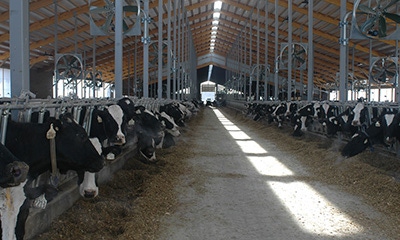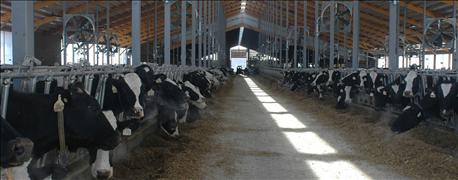June 27, 2016

Mastitis is the leading cause of economic losses on most dairy farms with each clinical case costing $200 or more. These losses result from decreased production, treatment costs, discarded milk, quality premium losses and culling. Environmental mastitis is caused by pathogens found in the environment in which the cow lives, and are routinely found in manure, bedding materials, feed stuffs, dust, soil and water.

Proper maintenance of resting, feeding and traffic areas are a must to control bacteria levels on the teat end.
The foundation of all mastitis control programs revolves around two things: reducing the amount of bacteria on the cow's teat and preventing the bacteria from getting into the cow's udder. When looking to reduce the bacteria load on the cow's teat end and trying to prevent bacteria from getting into the cow's udder, there are three areas of concern: milking equipment, milking technique and the environment. If you have a major breakdown in any one of these areas it then becomes the limiting factor for improvement. However, on dairy farms with elevated bulk tank counts of 300,000 or less, it’s often a minor breakdown in all three areas that leads to an elevated somatic cell count.
Control of environmental mastitis is achieved by decreasing the exposure of teat ends to pathogens that exist in the cow’s environment. It helps to minimize conditions which increase exposure to these pathogens such as overcrowding, elevated temperature and humidity in barns, poor ventilation, and dirty maternity and calving areas.
Milking systems must also be maintained on a regular basis. Malfunctioning equipment can cause liner slips resulting in teat end impacts. When this occurs inside the liner it causes the pathogens to be forced into the udder which increases the likelihood of a mastitis infection.
SCC testing, quality premiums, effective pre and post-dips, properly maintained milking equipment and good milking techniques are all good tools for preventing mastitis. However, we often ignore the cow’s environment. We can blame the cow, burn the hair off her udder, dock her tail, adjust the milking system, switch liners, and change milking techniques, but all of these practices are negated if we are milking a cow with teats covered with mud and manure.
It doesn't matter if you use a dry lot, stall barn, bedded pack, freestall, or a managed grazing system; proper maintenance of resting, feeding and traffic areas are a must to control bacteria levels on the teat end. The basic areas involved in freestall and stall barn systems include daily maintenance and cleaning of stalls. This includes bedding replacement and stall bed maintenance for sand based stalls. Poor bedding and stall maintenance is the primary cause of dysfunctional freestalls, and cattle lanes need to be cleaned 2-3 times daily.
Cattle lot design is also important for keeping cows clean. Concrete should be provided around permanent feed bunks with a proper slope for drainage. A 3% slope perpendicular to the feed bunk with a 1-2% longitudinal slope on a concrete lot has proven effective. There really is no such thing as a "dry lot". When weather conditions deteriorate in grass cattle lots more maintenance is needed, especially in the spring when dirt lots make it difficult to keep cows clean. In dirt lots a dry resting area with a base of concrete or macadam should be provided so the cows can be locked out of the muddy areas. These resting areas should provide a minimum of 80 square feet per cow.
Macadam consists of a base of two - six inch layers of packed breaker rock covered with 4 inches of crushed limestone or fine screenings. This base is excellent for cattle lanes and lots and costs about 50% less than concrete. Macadam can be used for cattle lanes and are also excellent for the transition areas in cow lots where the concrete meets soil. These areas always become muddy due to water runoff and traffic. The macadam base allows the water to drain while maintaining a solid base for cows to walk and lay on. Contact your UW-Extension Office for more information on how to properly build macadam lanes and pads for cattle feeding and resting areas.
Reducing the exposure of environmental bacteria on the teat end needs to be a primary concern in any mastitis control program. This cannot be totally accomplished by washing the cow’s udder prior to milking or by dipping. It must also begin outside with proper housing design, proper bedding, ongoing maintenance, and attention to the details that result in keeping cows clean if you want to maximize milk quality and ensure profitability.
Mayer is the Green County Extension dairy and livestock agent.
You May Also Like




